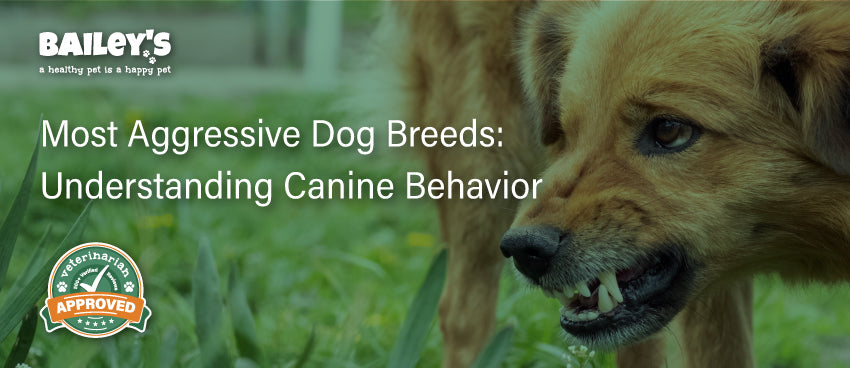Most Aggressive Dog Breeds: Understanding Canine Behavior

Understanding the behavior of dogs is crucial for any responsible dog owner or potential pet adopter. Certain dog breeds have been labeled as "aggressive," but it is essential to delve deeper into their behavior to gain a comprehensive understanding.
Together we aim to explore the factors influencing canine aggression, the top aggressive dog breeds, strategies for preventing and managing aggression, and the role of responsible ownership.
While excellent supplements from Bailey’s CBD may help with canine behavior, this article delves into a well-rounded look at dog aggression and how to prevent it in your favorite furry friend.
Table of Contents
1. Defining Aggression in Dogs
Before discussing specific breeds, it is important to define aggression in dogs. Aggression refers to any behavior displayed by a dog with the intent to cause harm or intimidation. It can manifest in various ways, including growling, barking, biting, snapping, or posturing. However, it is crucial to remember that aggression is not solely determined by breed but can be influenced by a combination of biological and environmental factors.
1.1 Biological Factors Influencing Canine Aggression
Research suggests that genetics play a role in a dog's propensity for aggression. Some breeds have a higher predisposition due to selective breeding practices that favor certain traits. These traits may have been advantageous in the past for specific working or guarding duties, leading to the perpetuation of aggressive tendencies. However, it is important to note that not all individuals within these breeds display aggressive behavior.

Genetic factors can interact with other biological factors to influence aggression in dogs. For example, hormonal imbalances, such as an excess of testosterone, can contribute to heightened aggression. Additionally, neurological conditions or brain abnormalities may affect a dog's behavior and increase the likelihood of aggression. Understanding these biological factors can help professionals in the field of animal behavior develop effective strategies for managing and modifying aggressive behavior in dogs.
Furthermore, it is worth mentioning that aggression in dogs is not limited to specific breeds. While certain breeds may have a higher prevalence of aggressive behavior, it is important to approach each dog as an individual and consider their unique genetic makeup and environmental experiences.
1.2 Environmental Factors Influencing Canine Aggression
The environment in which a dog is raised can significantly impact its behavior. Lack of socialization, inadequate training, abuse, neglect, and exposure to violence can all contribute to the development of aggressive traits. Dogs that are not exposed to a variety of people, animals, and environments during their critical socialization period may struggle with fear and anxiety, which can manifest as aggression.
Proper socialization is crucial for dogs to learn appropriate behaviors and develop positive associations with various stimuli. Early exposure to different situations, sounds, and experiences can help dogs become well-adjusted and less prone to aggression. It is the responsibility of dog owners to ensure that their pets receive adequate socialization and positive reinforcement training to prevent the development of aggressive tendencies.

Additionally, the quality of care and treatment a dog receives from its owner or caregiver can greatly influence its behavior. Dogs that experience abuse or neglect are more likely to exhibit aggressive behavior as a result of fear, mistrust, or a defensive response to perceived threats. Providing a safe and nurturing environment, along with consistent and positive training methods, is essential for preventing and addressing aggression in dogs.
It is important to note that aggression in dogs is a complex issue, and there is no one-size-fits-all solution. Each case should be evaluated individually, taking into account the dog's genetic predispositions, environmental factors, and any underlying medical or behavioral conditions. Seeking professional help from a qualified veterinarian or animal behaviorist is recommended for a comprehensive assessment and tailored treatment plan.
2. Top Aggressive Dog Breeds
While aggression can be seen in dogs of all breeds, some breeds have gained a reputation for their potential for aggression. However, it is crucial to recognize that aggression is not an inherent characteristic of these breeds but rather a result of various factors. The following breeds are often labeled as aggressive:

- Pit Bull Terrier: The Pit Bull Terrier is a breed that often tops the list of aggressive dog breeds. However, it is important to note that aggression in Pit Bulls is often a result of improper breeding, lack of socialization, or mistreatment by owners. With proper training and responsible ownership, Pit Bulls can be loving and loyal companions.
- Rottweiler: Rottweilers are known for their strength and protective nature. While they can be aggressive if not properly trained and socialized, Rottweilers can also be gentle and affectionate family dogs. Early socialization and consistent training are key to preventing aggression in this breed.
- German Shepherd: German Shepherds are intelligent and highly trainable dogs. However, their protective instincts can sometimes lead to aggression if not properly channeled. With early socialization, positive reinforcement training, and a loving environment, German Shepherds can be excellent family pets.
2.1 Breed-Specific Traits and Aggression
Each dog breed has its unique set of traits, which may contribute to the perception of aggression. Some breeds have a strong prey drive, high energy levels, or a strong protective instinct, which, if not channeled appropriately, can lead to aggression. It is important for potential dog owners to thoroughly research and understand the specific traits of any breed before making a decision.
For example, breeds such as the Doberman Pinscher and the Akita are known for their loyalty and protective nature. While these traits make them excellent guard dogs, they can also result in aggression if not properly trained and socialized. Understanding the breed-specific traits and needs is essential to ensure a harmonious relationship between the dog and its owner.
2.2 Misconceptions About Breed Aggression
It is crucial to dispel misconceptions surrounding breed aggression. While certain breeds may have a predisposition to aggression, individual behavior can vary greatly within a breed. Factors such as socialization, training, and responsible ownership play crucial roles in shaping a dog's behavior. Stereotyping any breed as inherently aggressive is unfair and perpetuates discrimination against specific breeds.
Related Article: Using CBD Dog Treats To Train Your Dog
It is important to remember that aggression in dogs is often a result of external influences, such as improper breeding, lack of socialization, or mistreatment. Responsible ownership, which includes proper training, socialization, and providing a safe and loving environment, can help prevent aggression in any breed.

Furthermore, it is essential to assess each dog as an individual rather than making assumptions based on breed stereotypes. Dogs, like humans, have unique personalities and temperaments that are shaped by their experiences and environment. By focusing on responsible ownership and understanding the individual needs of each dog, we can promote a more compassionate and inclusive approach to dog ownership.
3. Understanding Canine Behavior
Gaining a deeper understanding of canine behavior is key to effectively managing aggression and ensuring the overall well-being of dogs.
Canine behavior is a complex and fascinating subject. Dogs, as social animals, have evolved a wide range of behaviors that allow them to communicate and interact with their environment. By delving into the intricacies of their behavior, we can better comprehend their needs and provide them with the care they deserve.
3.1 The Role of Training in Behavior
Training plays a significant role in shaping a dog's behavior. Positive reinforcement methods, such as rewards and praise, are highly effective in promoting desirable behavior and reducing aggressive tendencies. Consistent training helps establish boundaries and teaches dogs appropriate ways to interact with humans and other animals.
When it comes to training, it is important to remember that dogs are individuals with unique personalities and learning styles. Some dogs may respond better to certain training techniques than others. Therefore, it is crucial for dog owners and trainers to be patient and adaptable, tailoring their approach to suit the specific needs of each dog.

Moreover, training should not be limited to basic obedience commands. Dogs thrive when provided with mental stimulation and enrichment activities. Engaging their minds through puzzle toys, scent games, and interactive play can help prevent behavioral issues and keep them mentally sharp.
3.2 The Impact of Socialization on Dog Behavior
Early and ongoing socialization is crucial for preventing aggression in dogs. Exposure to various environments, people, animals, and stimuli helps dogs develop confidence and learn appropriate ways to interact with their surroundings. Owners should actively seek opportunities to expose their dogs to different situations while ensuring safety and positive experiences for their pets.
During the critical socialization period, which typically occurs between 3 and 14 weeks of age, puppies are most receptive to new experiences. Introducing them to a wide range of people, including children, adults, and individuals wearing different types of clothing, can help them become comfortable with diverse human interactions. Similarly, exposing them to various sounds, such as traffic noises, vacuum cleaners, and fireworks, can help desensitize them to loud noises and prevent fear-based aggression.
Additionally, socializing dogs with other animals, both of their breed and other breeds, can enhance their ability to communicate and interact appropriately. Well-socialized dogs are more likely to exhibit friendly and non-threatening behavior towards other animals, reducing the risk of aggression or fear-based reactions.
It is important to note that socialization should be an ongoing process throughout a dog's life. Regular exposure to new experiences and environments helps dogs maintain their social skills and adaptability. By continuing to socialize dogs into adulthood, owners can ensure that their furry companions remain well-adjusted and confident in various situations.
4. Preventing and Managing Aggression in Dogs
Addressing and managing aggression is vital for the safety and well-being of both the dog and its environment.
4.1 Early Intervention Strategies
Recognizing signs of aggression and addressing them early is essential. Consulting with a professional dog trainer or behaviorist can help identify the underlying causes and develop a tailored plan for intervention. Early intervention can prevent the escalation of aggressive behavior and improve the chances of successful modification.
4.2 Professional Help for Aggressive Dogs
In cases of severe aggression, seeking the assistance of a professional dog behaviorist is crucial. These experts can assess the dog's behavior, identify triggers, and develop a thorough behavior modification plan. With proper guidance and management, many dogs with aggression issues can lead fulfilling lives while minimizing potential risks.
5. The Role of Responsible Ownership
Responsible ownership is crucial for the prevention of aggression and the overall well-being of dogs.
5.1 Choosing the Right Breed for Your Lifestyle
Before adopting a dog, potential owners should thoroughly research and consider their lifestyle and the specific needs of different breeds. Matching the energy level, exercise requirements, and temperament of a dog to the owner's lifestyle minimizes the risk of behavioral issues arising from unfulfilled needs.
5.2 The Importance of Regular Veterinary Check-ups
Regular veterinary check-ups are essential for identifying and addressing any underlying medical conditions that may contribute to aggression. Pain, illness, or other medical issues can cause a dog to exhibit aggressive behavior. Veterinary professionals can help identify and develop appropriate treatment plans for these dogs.
6. Conclusion
Understanding aggression in dogs requires a holistic approach that considers genetic, environmental, and behavioral factors. While certain breeds may have a predisposition to aggression, individual behavior can vary greatly, emphasizing the importance of responsible ownership, proper training, and socialization. You can also consult your veterinarian about the use of high-quality supplements that may help your dog. By providing a nurturing environment, early intervention, and seeking professional help when necessary, it is possible to prevent and effectively manage aggression in dogs, ensuring a safe and harmonious coexistence between canines and humans.These products have not been evaluated by the FDA and are not intended to diagnose, treat, cure, or prevent any disease.











